The Effect of Pesticide Formulation on the Characteristics of Air-Induction Sprays
Abstract
1. Introduction
2. Materials and Methods
2.1. Experimental Facilities and Materials
2.2. Capturing of Liquid Sheet
3. Results and Discussion
3.1. Spray Angle and BREAKUP Characteristics of Air-Induction Sprays Under Oil-Based Emulsion Conditions
3.2. Spray Angle and Breakup Characteristics of Air-Induction Sprays Under Suspension Agent Conditions
3.3. Spray Angle and Breakup Characteristics of Air-Induction Sprays Under Aqueous Solution Conditions
4. Conclusions
- (1)
- Oil-based emulsion solution reduces breakup length by about 33.77% compared to that of water air-induction spray. Oil-based emulsion also decreases the surface tension of the solution, increasing the spray angle by approximately 9.73%. We proposed that the oil drop in the oil-based emulsion contributes to the rupture of bubbles in the liquid sheet by tearing bubbles or moving them to the gas–liquid interface. Moreover, oil drops directly impact liquid sheet breakup through “bridging-stretching” or “bridging-dewetting” mechanisms.
- (2)
- For suspension sprays, surface tension decreases slightly with concentration, showing little difference from water at 0.02% and 0.1%. As the suspension concentration increases, more solid particles enhance rupture of bubbles and liquid sheet breakup, reducing average bubble size and breakup length while increasing small bubble count. The surface tension reduction also enlarges the spray liquid spray angle.
- (3)
- The surface tension of aqueous solutions decreases with concentration. This reduces average bubble size and increases bubble count. Surfactants in the solution lower surface tension, stabilize bubbles, and increase gas bubble formation. In aqueous solutions sprays, both the liquid sheet spray angle and breakup length increase with solution concentration.
- (4)
- Currently, our research on the characteristics of air-induction spray primarily relies on image-based methods. However, due to limitations in measurement accuracy and the limited number of images, certain measurement errors may occur. To address this issue, we believe future studies can focus on two aspects. The first is adopting more advanced high-speed imaging equipment to improve image resolution and increase the number of captured images. The second is employing alternative methods beyond image-based techniques to measure the characteristics of aspirated sprays.
Author Contributions
Funding
Data Availability Statement
Acknowledgments
Conflicts of Interest
References
- Ma, J.; Liu, K.; Dong, X.; Huang, X.; Ahmad, F.; Qiu, B. Force and motion behaviour of crop leaves during spraying. Biosyst. Eng. 2023, 235, 83–99. [Google Scholar] [CrossRef]
- Qin, W.-C.; Qiu, B.-J.; Xue, X.-Y.; Chen, C.; Xu, Z.-F.; Zhou, Q.-Q. Droplet deposition and control effect of insecticides sprayed with an unmanned aerial vehicle against plant hoppers. Crop Prot. 2016, 85, 79–88. [Google Scholar] [CrossRef]
- Shen, Y.; Zhu, H.; Liu, H.; Chen, Y.; Ozkan, E. Development of a laser-guided, embedded-computer-controlled, air-assisted precision sprayer. Trans. ASABE 2017, 60, 1827–1838. [Google Scholar] [CrossRef]
- Ahmad, F.; Zhang, S.; Qiu, B.; Ma, J.; Xin, H.; Qiu, W.; Ahmed, S.; Chandio, F.A.; Khaliq, A. Comparison of Water Sensitive Paper and Glass Strip Sampling Approaches to Access Spray Deposit by UAV Sprayers. Agronomy 2022, 12, 1302. [Google Scholar] [CrossRef]
- Li, J.; Nie, Z.; Chen, Y.; Ge, D.; Li, M. Development of Boom Posture Adjustment and Control System for Wide Spray Boom. Agriculture 2023, 13, 2162. [Google Scholar] [CrossRef]
- Shi, Q.; Mao, H.; Guan, X. Numerical simulation and experimental verification of the deposition concentration of an unmanned aerial vehicle. Appl. Eng. Agric. 2019, 35, 367–376. [Google Scholar] [CrossRef]
- Zhang, C.; Zhai, C.; Zhang, M.; Zhang, C.; Zou, W.; Zhao, C. Staggered-Phase Spray Control: A Method for Eliminating the Inhomogeneity of Deposition in Low-Frequency Pulse-Width Modulation (PWM) Variable Spray. Agriculture 2024, 14, 465. [Google Scholar] [CrossRef]
- Ferguson, J.C.; Chechetto, R.G.; Adkins, S.W.; Hewitt, A.J.; Chauhan, B.S.; Kruger, G.R.; O’Donnell, C.C. Effect of spray droplet size on herbicide efficacy on four winter annual grasses. Crop Prot. 2018, 112, 118–124. [Google Scholar] [CrossRef]
- Liao, J.; Hewitt, A.J.; Wang, P.; Luo, X.; Zang, Y.; Zhou, Z.; Lan, Y.; O’Donnell, C. Development of droplet characteristics prediction models for air induction nozzles based on wind tunnel tests. Int. J. Agric. Biol. Eng. 2019, 12, 1–6. [Google Scholar] [CrossRef]
- Liao, J.; Luo, X.; Wang, P.; Zhou, Z.; O’Donnell, C.C.; Zang, Y.; Hewitt, A.J. Analysis of the Influence of Different Parameters on Droplet Characteristics and Droplet Size Classification Categories for Air Induction Nozzle. Agronomy 2020, 10, 256. [Google Scholar] [CrossRef]
- Wang, C.; Zeng, A.; He, X.; Song, J.; Herbst, A.; Gao, W. Spray drift characteristics test of unmanned aerial vehicle spray unit under wind tunnel conditions. Int. J. Agric. Biol. Eng. 2020, 13, 13–21. [Google Scholar] [CrossRef]
- Gong, C.; Li, D.; Yan, S.; Kang, C.; Ding, K. Relation between bubble behaviors in spray sheet and bubbly flow inside an air-induction fan nozzle: A visualization study. Phys. Fluids 2024, 36, 103362. [Google Scholar] [CrossRef]
- Abdelmotalib, H.M.; Dafsari, R.A.; Seung-Hwa, Y.; Lee, J. Computational study of internal flow characteristics of the air induction nozzle. Int. J. Mech. Sci. 2021, 204, 106578. [Google Scholar] [CrossRef]
- Butts, T.R.; Luck, J.D.; Fritz, B.K.; Hoffmann, W.C.; Kruger, G.R. Evaluation of spray pattern uniformity using three unique analyses as impacted by nozzle, pressure, and pulse-width modulation duty cycle. Pest Manag. Sci. 2019, 75, 1875–1886. [Google Scholar] [CrossRef] [PubMed]
- Post, S.L.; Hewitt, A.J. Flat-Fan Spray Atomization Model. Trans. ASABE 2018, 61, 1249–1256. [Google Scholar] [CrossRef]
- Post, S.L. Drift of Droplets from Air-Induction Nozzles. Trans. ASABE 2019, 62, 1683–1687. [Google Scholar] [CrossRef]
- Dafsari, R.A.; Yu, S.; Choi, Y.; Lee, J. Effect of geometrical parameters of air-induction nozzles on droplet characteristics and behaviour. Biosyst. Eng. 2021, 209, 14–29. [Google Scholar] [CrossRef]
- McArtney, S.J.; Obermiller, J.D. Comparative performance of air-induction and conventional nozzles on an axial fan sprayer in medium density apple orchards. Horttechnology 2008, 18, 365–371. [Google Scholar] [CrossRef]
- Miller, P.C.H.; Ellis, M.C.B. Effects of formulation on spray nozzle performance for applications from ground-based boom sprayers. Crop Prot. 2000, 19, 609–615. [Google Scholar] [CrossRef]
- Gong, C.; Li, D.; Kang, C. Visualization of the evolution of bubbles in the spray sheet discharged from the air-induction nozzle. Pest Manag. Sci. 2022, 78, 1850–1860. [Google Scholar] [CrossRef]
- Gong, C.; Li, D.; Kang, C.; Wang, Y. Visualisation of the evolution of perforations in oil-based emulsion sheets formed by flat-fan spray nozzles. Biosyst. Eng. 2021, 207, 68–80. [Google Scholar] [CrossRef]
- Hu, J.; Liu, C.; Wang, Z.; Li, Y.; Song, J.; Liu, Y.; Chu, X. Motion model for describing the quantity of air in droplets through changing the structure of air induction nozzle. Int. J. Agric. Biol. Eng. 2021, 14, 35–40. [Google Scholar] [CrossRef]
- Dorr, G.J.; Hewitt, A.J.; Adkins, S.W.; Hanan, J.; Zhang, H.; Noller, B. A comparison of initial spray characteristics produced by agricultural nozzles. Crop Prot. 2013, 53, 109–117. [Google Scholar] [CrossRef]
- Combellack, J.H.; Westen, N.M.; Richardson, R.G. A comparison of the drift potential of a novel twin fluid nozzle with conventional low volume flat fan nozzles when using a range of adjuvants. Crop Prot. 1996, 15, 147–152. [Google Scholar] [CrossRef]
- Yang, W.; Jia, W.; Ou, M.; Zhong, W.; Jiang, L.; Wang, X. Effect of Physical Properties of an Emulsion Pesticide on the Atomisation Process and the Spatial Distribution of Droplet Size. Agriculture 2022, 12, 949. [Google Scholar] [CrossRef]
- Yang, W.; Zhong, W.; Jia, W.; Ou, M.; Dong, X.; Zhang, T.; Ding, S.; Yu, P. The effect of oil-in-water emulsion pesticide on the evolution of liquid sheet rim disintegration and the spraying distribution. Crop Prot. 2024, 177, 106547. [Google Scholar] [CrossRef]
- Denkov, N.D.; Marinova, K.G.; Tcholakova, S.S. Mechanistic understanding of the modes of action of foam control agents. Adv. Colloid Interface Sci. 2014, 206, 57–67. [Google Scholar] [CrossRef]
- Ni, R. Deformation and Breakup of Bubbles and Drops in Turbulence. Annu. Rev. Fluid Mech. 2024, 56, 319–347. [Google Scholar] [CrossRef]

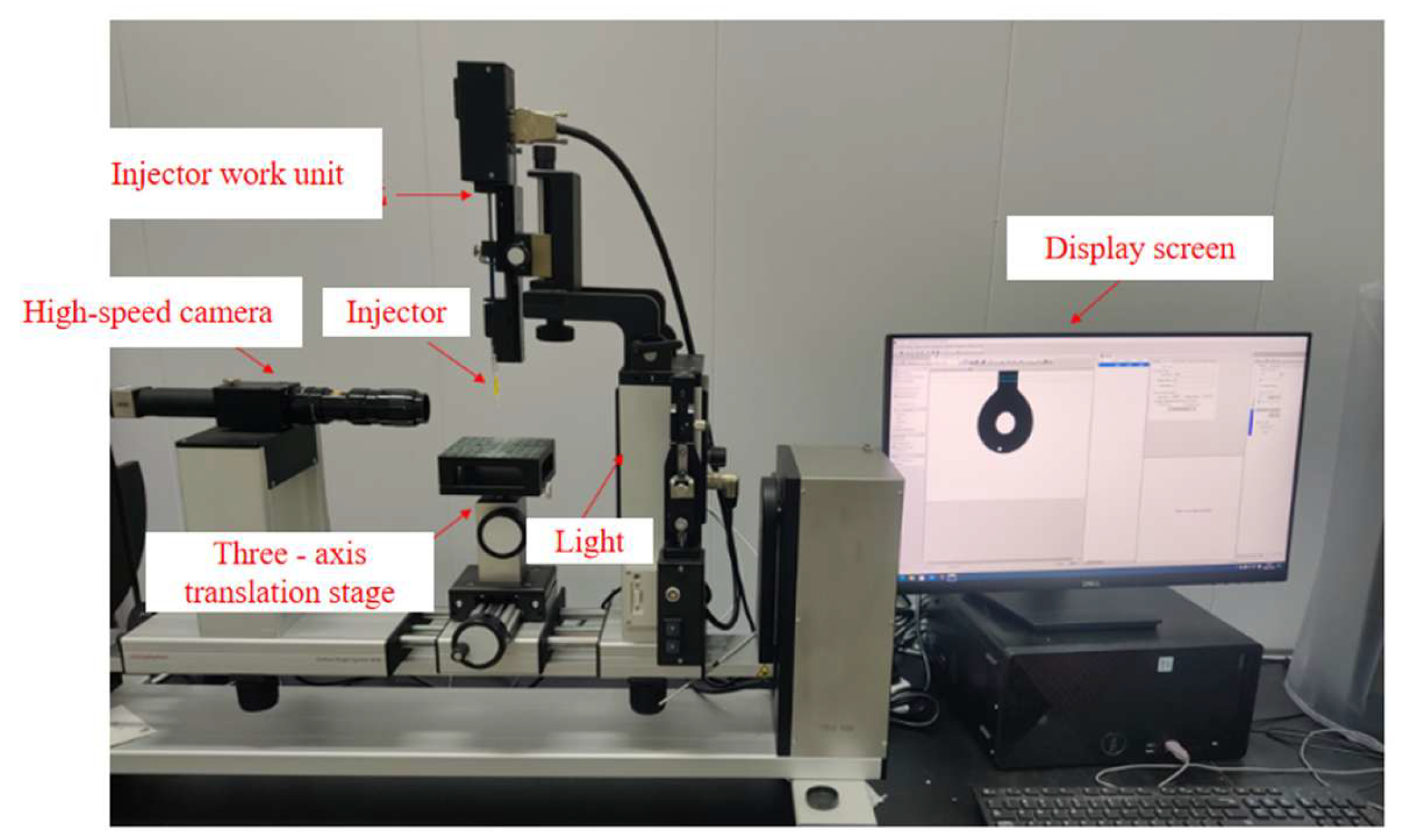
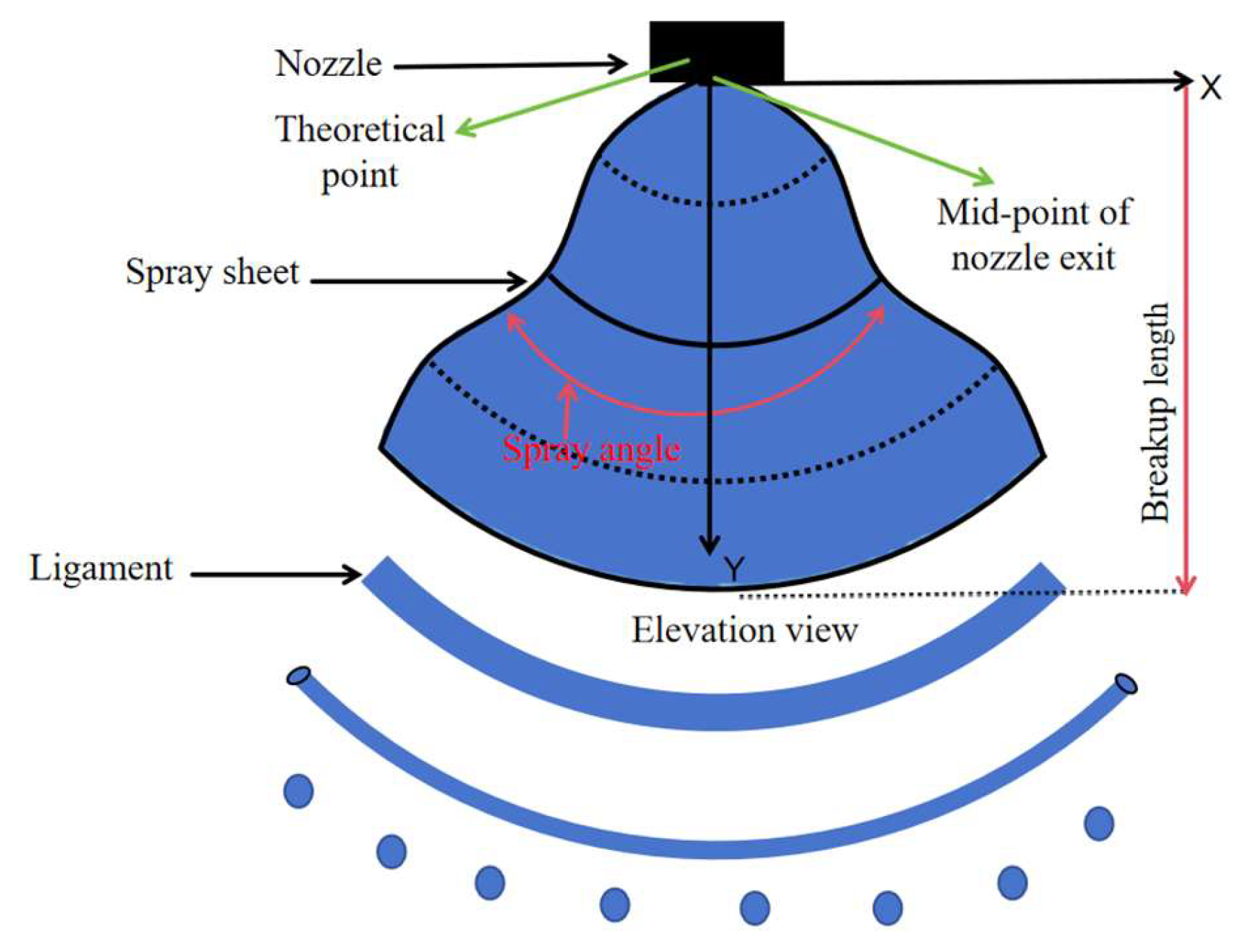
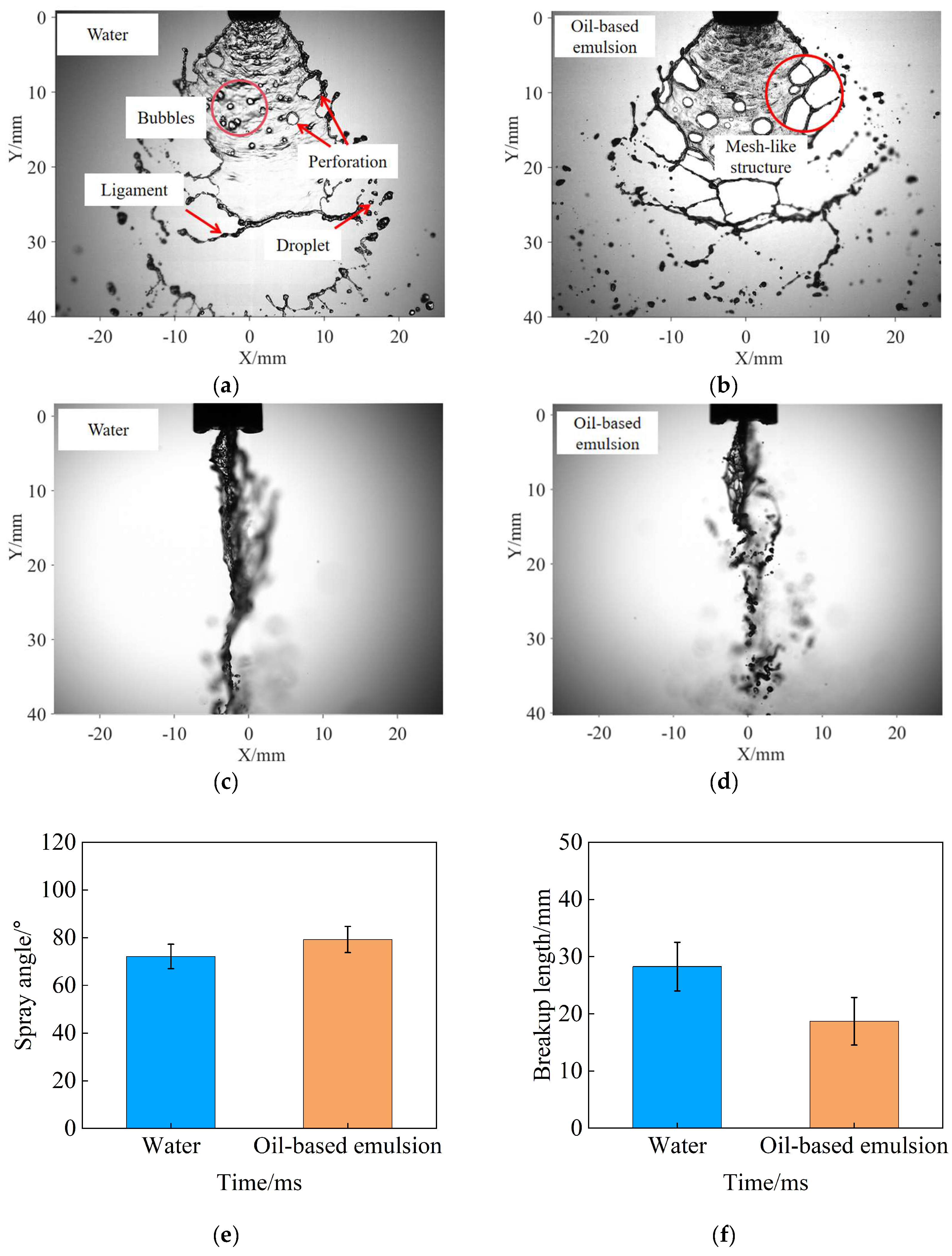
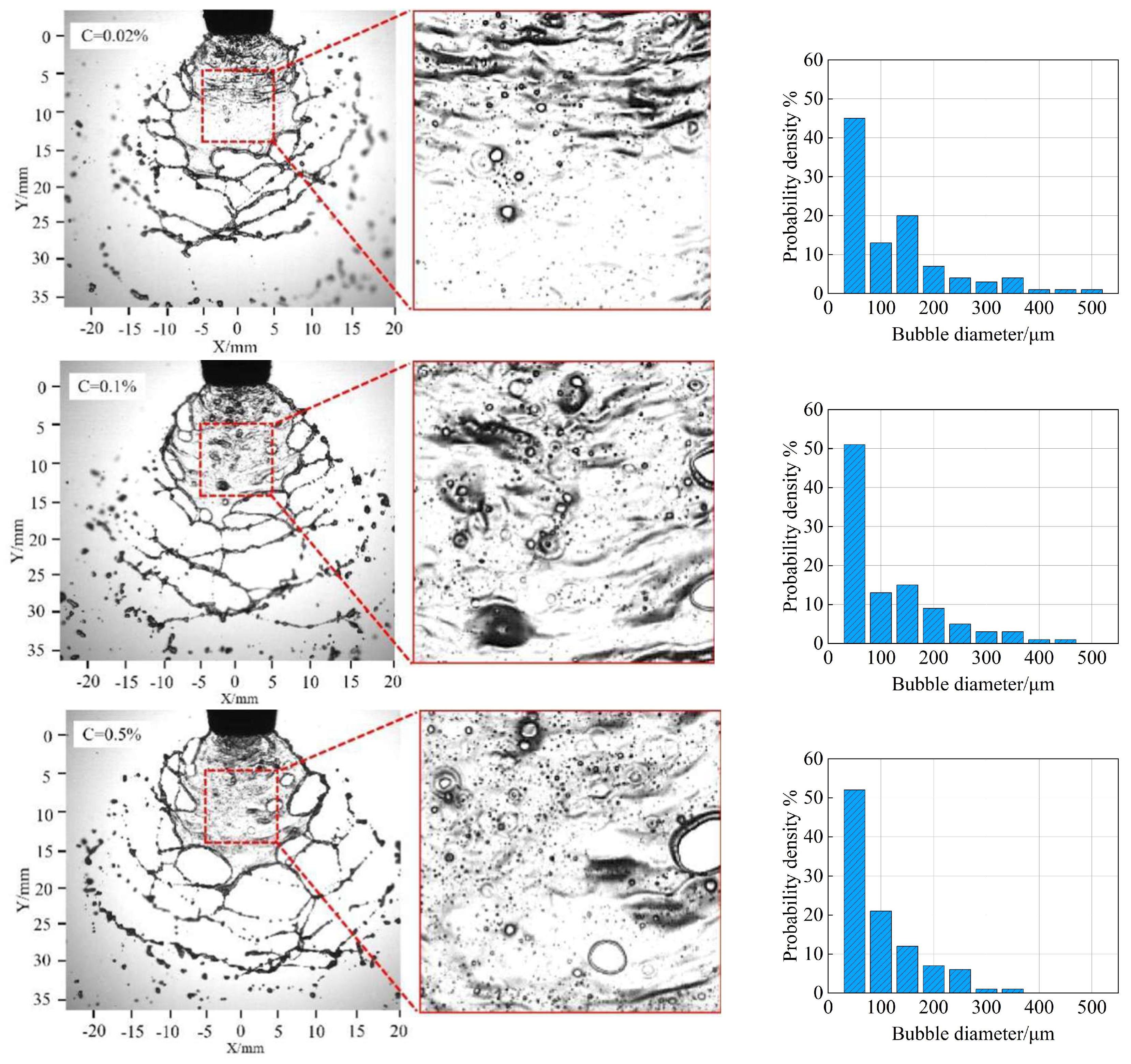


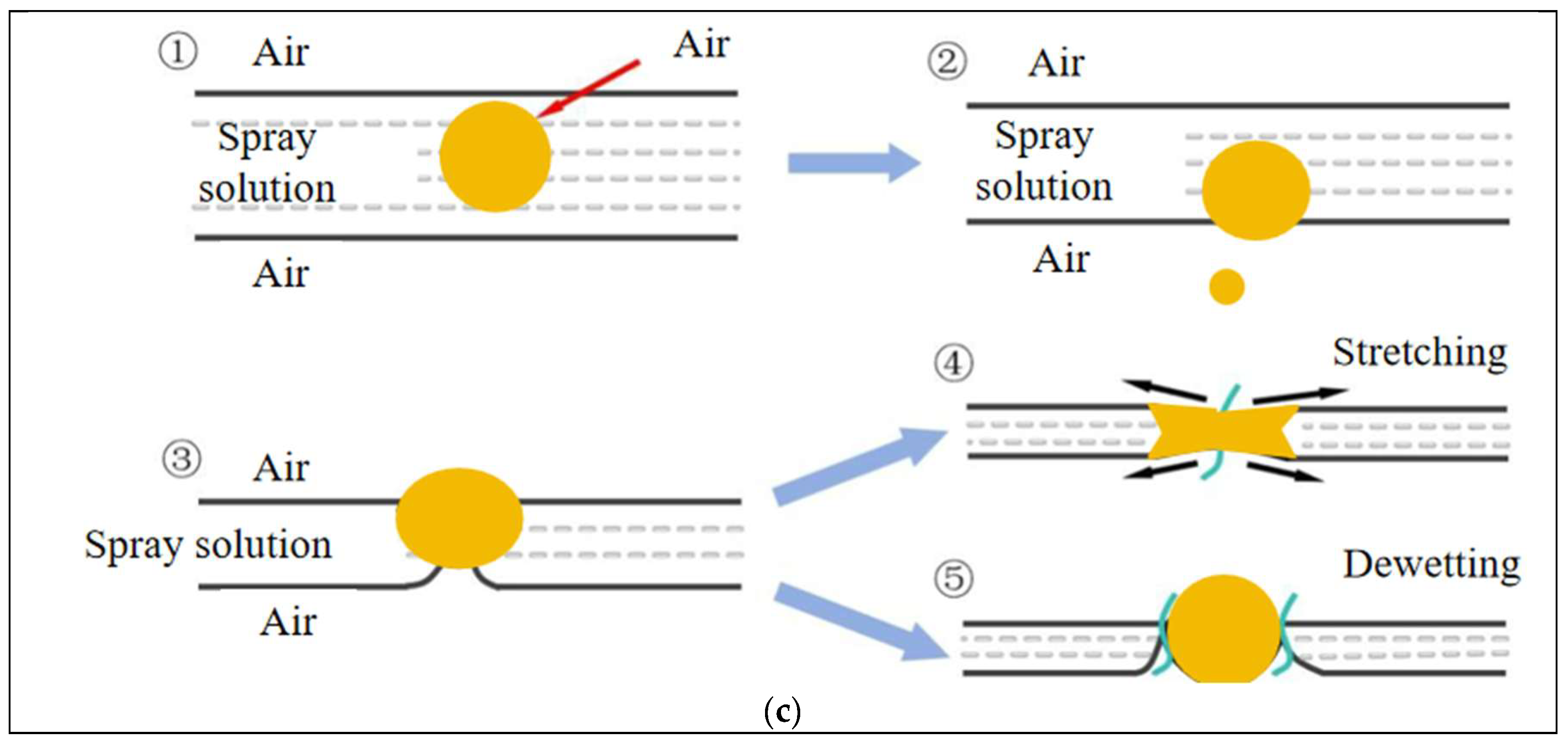


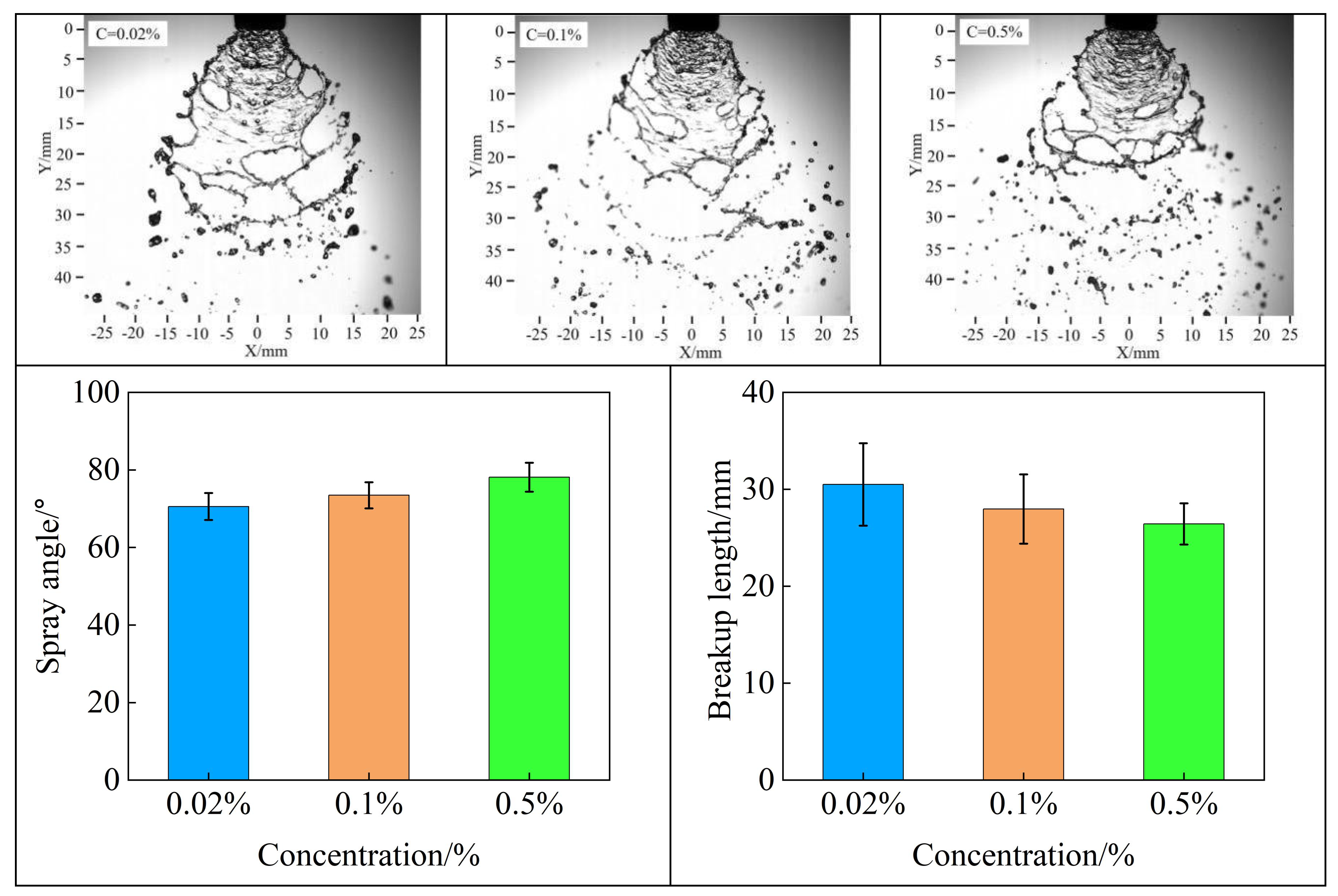



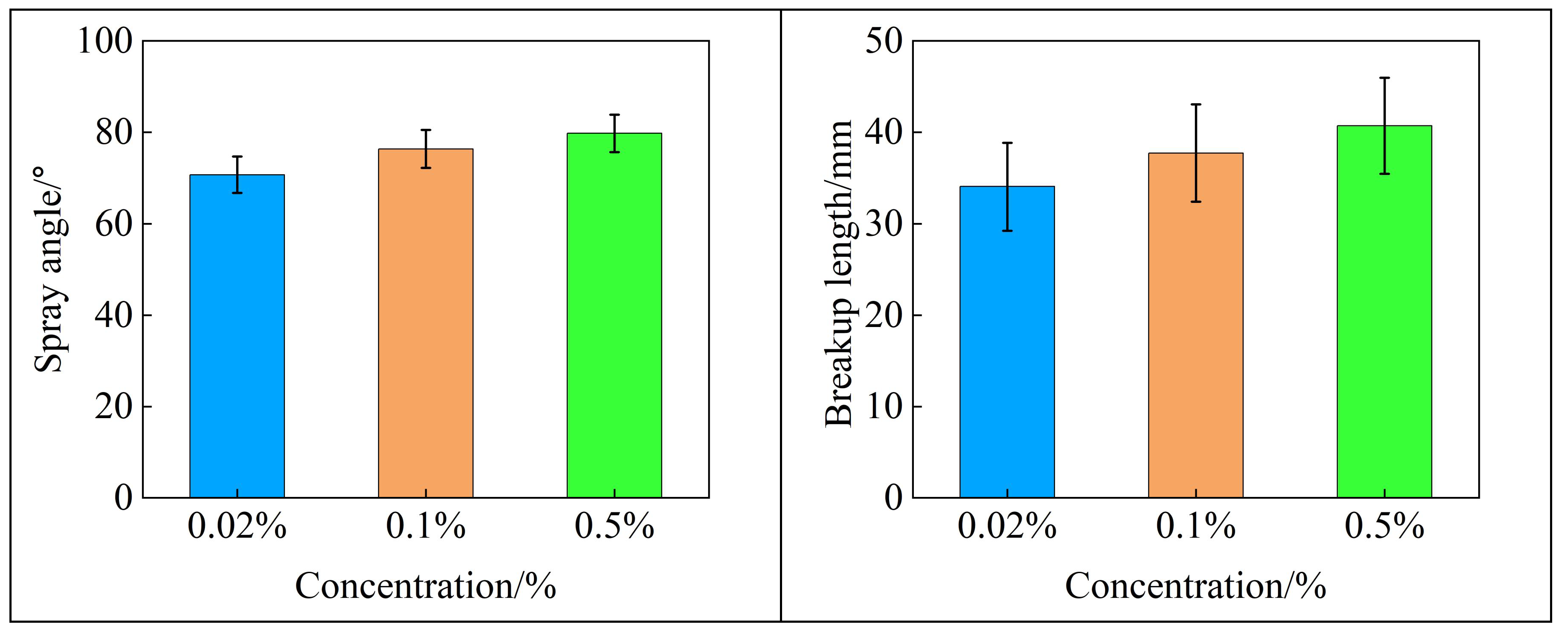
| Nozzle Type | Liquid Inlet Diameter Dl/mm | Air Inlet Diameter Da/mm | V-Notch Angle a/° | Long Axis Diameter of Nozzle Outlet DL/mm | Short Axis Diameter of Nozzle Outlet DS/mm |
|---|---|---|---|---|---|
| ID120-03 | 1.29 | 1.54 | 31 | 2.98 | 0.99 |
| Concentration/% | 0.02% | 0.1% | 0.5% |
|---|---|---|---|
| Butachlor | 51.04 ± 0.85 | 42.35 ± 0.98 | 32.43 ± 0.443 |
| Atrazine | 69.43 ± 0.24 | 64.22 ± 0.78 | 48.78 ± 0.78 |
| Glufosinate ammonium | 63.64 ± 1.72 | 38.82 ± 0.67 | 29.75 ± 0.25 |
Disclaimer/Publisher’s Note: The statements, opinions and data contained in all publications are solely those of the individual author(s) and contributor(s) and not of MDPI and/or the editor(s). MDPI and/or the editor(s) disclaim responsibility for any injury to people or property resulting from any ideas, methods, instructions or products referred to in the content. |
© 2025 by the authors. Licensee MDPI, Basel, Switzerland. This article is an open access article distributed under the terms and conditions of the Creative Commons Attribution (CC BY) license (https://creativecommons.org/licenses/by/4.0/).
Share and Cite
Yan, M.; Chen, F.; Gong, C.; Kang, C. The Effect of Pesticide Formulation on the Characteristics of Air-Induction Sprays. Agronomy 2025, 15, 979. https://doi.org/10.3390/agronomy15040979
Yan M, Chen F, Gong C, Kang C. The Effect of Pesticide Formulation on the Characteristics of Air-Induction Sprays. Agronomy. 2025; 15(4):979. https://doi.org/10.3390/agronomy15040979
Chicago/Turabian StyleYan, Mingzhi, Fujun Chen, Chen Gong, and Can Kang. 2025. "The Effect of Pesticide Formulation on the Characteristics of Air-Induction Sprays" Agronomy 15, no. 4: 979. https://doi.org/10.3390/agronomy15040979
APA StyleYan, M., Chen, F., Gong, C., & Kang, C. (2025). The Effect of Pesticide Formulation on the Characteristics of Air-Induction Sprays. Agronomy, 15(4), 979. https://doi.org/10.3390/agronomy15040979






